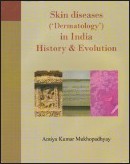Translate this page into:
Skin diseases ("Dermatology") in India - History and Evolution: Amiya Kumar Mukhopadhyay
Correspondence Address:
Devinder M Thappa
Editor-in-Chief, Indian Journal of Dermatology, Venereology and Leprology, Professor and Head, Dermatology and STD Department, JIPMER, Pondicherry - 605 006
India
| How to cite this article: Thappa DM. Skin diseases ("Dermatology") in India - History and Evolution: Amiya Kumar Mukhopadhyay. Indian J Dermatol Venereol Leprol 2011;77:629 |
 Publisher: Allied Book Agency, Kolkata, 1 st edition
Publisher: Allied Book Agency, Kolkata, 1 st edition
Pages: 184; Price: INR 500
The systematic study of the history of medicine will enrich our present knowledge with much new information gathered by our ancestors with much care and great difficulties. This whole story holds true for any and every branch of medicine including dermatology.
"Nothing is as sacred as knowledge in this universe" is the quotation with which this book starts, followed by a foreword by Dr. Nitin S. Vora and preface by Professor (Dr.) Karl Holubar. In the "Introduction," he gives the overview of the book and mentions the people who helped him in the realization of this project. Basically, he has divided his book into sections A-K. Section A (Few preliminary words) has three chapters: Preamble, a few words about modern day dermatology, and Dermatology, history and history of dermatology: really we need to know about them? Section B (Skin diseases in ancient India - Prehistoric period - c. 800 AD) has eight chapters: Prehistoric period and medicine: Indian scenario; Protohistoric period - the "Dark Millennium" of Indian history (c. 2500 BC- 1500 BC); Skin and its diseases in Vedic period (1500 BC-800 BC); The later Vedic period: The period of Brahmanas and Upanisadas (c. 800 BC-600 BC); Buddhism and Jainism: The new age religions - Their influence on medicine; Skin diseases in post Vedic period; Bower′s manuscript and skin diseases; and Siddha medicine - An indigenous system of medicine. Section C (Skin diseases in medieval India - 800 AD-1700 AD) has three chapters: Introduction; Skin diseases in major Ayurvedic works; and Unani system of medicine and skin diseases. Section D (Dermatology in modern India - 1700 AD-till date) has eight chapters: Introduction; Skin diseases and Ayurveda - Revival and dermatology; Unani system of medicine and dermatology; Effect of western medicine in India: Allopathy and dermatology; Effect of western medicine in India: Homeopathy and dermatology; Other alternative systems of medicine and dermatology; Tribal medicine and folk medicine: A brief overview; and Quackery and dermatology. Then there are Sections E (Epilogue), F (Landmarks in the history of Indian dermatology and related subjects), G (Medicinal plants with botanical names), H (books that were regularly consulted and extensively quoted), I (some important books for further reading), J (illustrations), and K (index). In short, this book is a short compendium on the history and evolution of skin diseases (dermatology) in India written with an objective of attracting the attention of the readers and scholars for further research on the subject.
The author in this book wants to emphasize and spread the message that the ancient Indian medical system was quite advanced in India. Though the present day medicinal system of the West expresses its debt to the Greeks only, yet it was the outcome of a mutual effect of the interaction between ancient Indian Medicine and the Greeks. The discovery of Bower′s manuscript at a place far away from the country (in ruins of Mingai, Kucha of Chinese Turkistan) showed that the concept and practice of Indian Medicine had spread far and wide. This Greco-Arabic medicine is the ground on which the edifice of modern Western Medicine has been built, so there must be some direct or indirect influence of ancient Indian Medicine and Ayurveda upon the Western Medicine.
He has listed and illustrated many Indian medicinal herbs used in treatment of skin diseases, but has not given the names of the diseases where they would be useful either in the table or figure legends. Illustrations of some rare books, stone carvings, moulages, etc., add an interesting facet to this book.
The occasional spelling mistake (whether Caraka or Charaka) and references repeated many times in the same chapter (e.g., Sehgal VN. Indian dermatology, Int J Dermatol 1993;32:838-44 repeated four times in the reference list) are mistakes probably inadvertently made. Many of these references are incomplete.
In spite of these minor mistakes, the amount of labor the author has put and the time devoted to compile a book of 184 pages is really commendable. The historian would love to collect a copy of this. Since this book will supplement the "History of the IADVL (1973-2009)" compiled by the IADVL History book team, edited by Dr. Uday Khopkar and Dr. DM Thappa (myself), the present day dermatologists and postgraduate students may find this book another source of tracing roots of Indian dermatology.
Fulltext Views
2,901
PDF downloads
3,167





